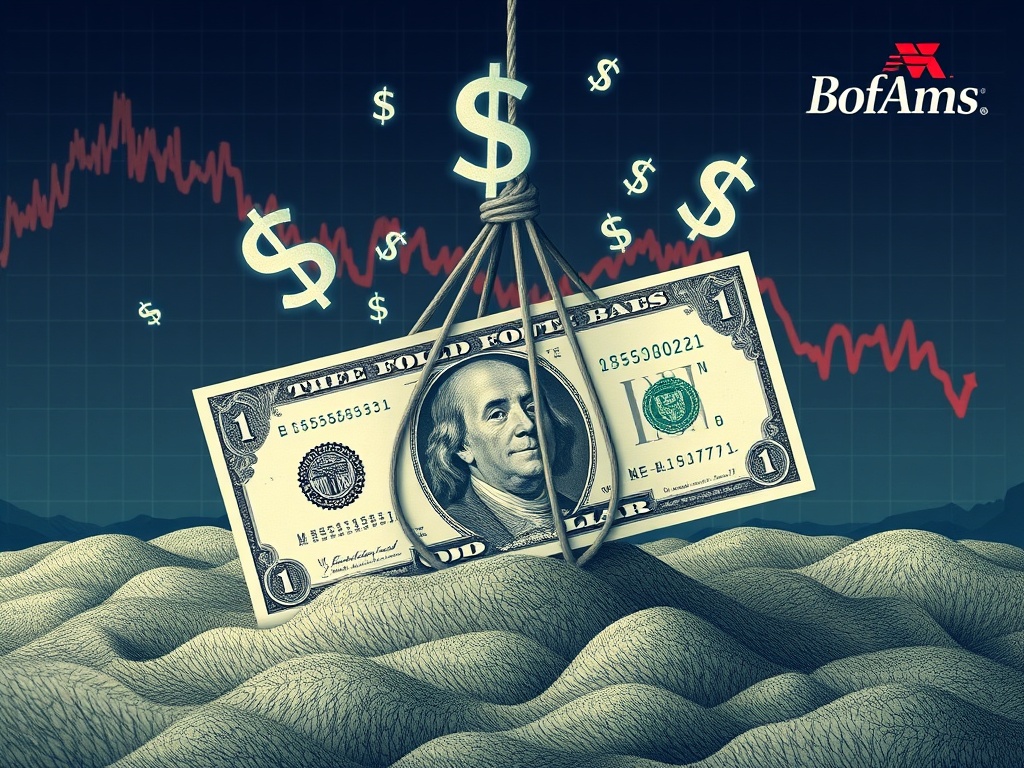BitcoinWorld

USD Pressure: Unveiling Why BofA Predicts Sustained Weakness
In the dynamic world of global finance, where every ripple in one market can create waves in another, the performance of the US Dollar remains a pivotal focus. For cryptocurrency enthusiasts and traditional investors alike, understanding the direction of the world’s reserve currency is paramount, as its strength or weakness can significantly influence asset prices, capital flows, and market sentiment. Recent analysis from Bank of America (BofA) offers a compelling perspective, suggesting that despite a temporary surge in July, the USD pressure is set to continue, pointing towards sustained weakness. But what exactly does this mean for your portfolio, and why are BofA’s insights so crucial?
Understanding the Persistent USD Pressure: What Does It Mean?
When analysts speak of ‘USD pressure,’ they are referring to a sustained tendency for the US Dollar to depreciate against other major global currencies. This isn’t just a fleeting daily fluctuation; it indicates a deeper, fundamental shift in market sentiment and economic factors that favor other currencies over the greenback. While July saw a brief period of strength for the dollar, largely driven by safe-haven demand amidst global uncertainties or specific economic data points, BofA’s deep dive into forex positioning suggests this was merely a temporary reprieve, not a reversal of the underlying trend.
The implications of persistent USD pressure are far-reaching. For international trade, a weaker dollar makes US exports cheaper and imports more expensive, potentially boosting American competitiveness but also fueling domestic inflation. For investors, it impacts the value of foreign assets when converted back to dollars and influences commodity prices, often leading to higher prices for dollar-denominated goods like gold and oil. Furthermore, for those deeply invested in cryptocurrencies, a weaker dollar environment can sometimes be seen as a bullish signal for digital assets, as investors seek alternatives to traditional fiat currencies to preserve purchasing power or gain exposure to growth assets.
BofA’s analysis moves beyond surface-level observations, delving into the intricate mechanics of market positioning to uncover where the ‘smart money’ is truly leaning. They argue that the July strength was likely driven by short-term tactical moves or unwinding of extreme short positions, rather than a fundamental shift in the dollar’s long-term trajectory. This distinction is vital for anyone trying to navigate the complex currents of the global currency trends.
Decoding Forex Positioning: What BofA Sees in the Data
At the heart of BofA’s forecast lies their meticulous examination of forex positioning. But what exactly is this? In essence, it refers to the net long or short positions held by large speculative traders in the currency futures market, as reported by bodies like the Commodity Futures Trading Commission (CFTC). These positions reflect the collective bets institutional investors and hedge funds are making on the future direction of various currency pairs.
BofA’s methodology often involves analyzing the Commitment of Traders (COT) report, a weekly publication detailing these positions. When a large number of speculative traders are net long a particular currency (meaning they expect it to rise), it can sometimes be a ‘contrarian’ signal. Why? Because if too many participants are already on one side of the trade, there are fewer new buyers to push the price higher, and any small negative news can trigger a cascade of selling as these crowded positions are unwound. Conversely, if traders are heavily net short, it suggests the currency might be oversold and due for a rebound.
BofA’s recent findings highlight that despite the dollar’s brief rally, speculative positioning suggests that the market remains structurally short on the dollar against key currencies. This indicates a deeply ingrained expectation of continued USD pressure among sophisticated market participants. Here’s a simplified look at what this positioning might imply:
- EUR/USD: Large net long positions in the Euro suggest a continued belief in Euro strength against the dollar, reinforcing the outlook for dollar weakness.
- USD/JPY: While there might be tactical shifts, persistent speculative short positions in the Japanese Yen against the dollar could be seen as an opportunity for a Yen rebound, further contributing to dollar depreciation.
- GBP/USD: Similar to the Euro, significant net long positions in the British Pound signal a conviction that Sterling will outperform the dollar.
This persistent forex positioning, where major players are betting against the dollar, is a strong indicator for BofA that the July strength was merely a blip. It implies that the structural factors driving dollar weakness are still very much in play, and the market is primed for further depreciation.
What Does This Mean for the US Dollar Outlook?
Based on their forex positioning analysis, BofA’s US Dollar outlook remains predominantly bearish for the medium to long term. This isn’t just about speculative bets; it’s underpinned by several fundamental economic and policy factors that continue to weigh on the dollar.
Key drivers contributing to this anticipated weakness include:
- Interest Rate Differentials: While the Federal Reserve has been aggressive in its rate hikes, other major central banks are also catching up or maintaining hawkish stances. If the interest rate differential narrows or even reverses, it reduces the attractiveness of dollar-denominated assets.
- Inflation Dynamics: Persistent inflation in the US, even as the Fed tries to tame it, can erode the purchasing power of the dollar, making it less appealing globally.
- Fiscal Deficits and Debt: The US continues to run substantial fiscal deficits, adding to its national debt. While not always an immediate concern for currency markets, long-term fiscal unsustainability can put downward pressure on a currency.
- Global Economic Recovery (or Divergence): If other major economies demonstrate stronger or more stable recovery paths compared to the US, capital may flow out of the dollar and into these regions, strengthening their currencies.
- Geopolitical Developments: While sometimes leading to safe-haven demand for the dollar, prolonged geopolitical tensions or shifts in global alliances can also encourage diversification away from the dollar.
The temporary strength observed in July could be attributed to various factors such as short-term risk aversion, a brief period of robust US economic data, or even a technical rebound from prior overselling. However, BofA emphasizes that these are unlikely to override the more entrenched factors influencing the US Dollar outlook. The bank’s conviction is that these underlying pressures will reassert themselves, leading to continued dollar depreciation.
Navigating Global Currency Trends Beyond the Dollar
A weakening dollar doesn’t exist in a vacuum; it profoundly influences global currency trends and the relative strength of other major currencies. When the USD pressure intensifies, it often implies strength for other major currencies, particularly the Euro, Japanese Yen, and British Pound, and potentially a broader rally in emerging market currencies.
Consider the ripple effect:
- Euro (EUR): As the largest component of the Dollar Index (DXY), the Euro often moves inversely to the dollar. A weaker dollar typically translates to a stronger Euro, especially if the European Central Bank maintains a hawkish stance or European economic data surprises positively.
- Japanese Yen (JPY): The Yen, often seen as a safe-haven currency, can benefit from dollar weakness, particularly if global risk sentiment improves or if the Bank of Japan shifts its ultra-loose monetary policy.
- British Pound (GBP): The Pound’s performance against a weaker dollar will depend heavily on the UK’s domestic economic stability, inflation trajectory, and the Bank of England’s policy decisions.
- Emerging Market Currencies: A weaker dollar generally provides a tailwind for emerging market currencies. It makes dollar-denominated debt cheaper to service and encourages capital inflows into higher-yielding developing economies.
The concept of ‘de-dollarization’ also plays a role in these global currency trends. While not an overnight phenomenon, growing discussions and actions by various countries to reduce their reliance on the US Dollar for trade and reserves can contribute to its long-term depreciation. This shift, driven by geopolitical considerations and the desire for greater financial autonomy, adds another layer to the bearish US Dollar outlook. Furthermore, the interplay between commodity prices and currency movements is crucial; a weaker dollar often supports higher commodity prices, which in turn can strengthen the currencies of commodity-exporting nations.
Key BofA Insights for Investors and Traders
The BofA insights derived from their detailed forex positioning analysis offer valuable guidance for investors and traders navigating the current market environment. Their core argument is clear: the market is positioned for continued USD pressure, and any rallies should be viewed with skepticism.
Here are some key takeaways from BofA’s perspective:
- Fade USD Rallies: BofA suggests that temporary periods of dollar strength should be seen as opportunities to ‘fade’ or sell into, rather than buy into. This implies taking short positions on the dollar during its rallies, anticipating a return to its downward trend.
- Favor Non-Dollar Assets: Given the bearish US Dollar outlook, investors might consider increasing their exposure to non-dollar denominated assets, including international equities, bonds, and commodities, particularly those priced in currencies expected to strengthen against the dollar.
- Monitor Central Bank Divergence: The divergence in monetary policy between the Federal Reserve and other major central banks will be a critical factor. BofA’s insights suggest that central banks adopting more hawkish stances or whose economies show greater resilience could see their currencies strengthen against the dollar.
- Structural vs. Tactical: It is crucial to distinguish between structural trends (long-term, fundamental) and tactical moves (short-term, speculative). BofA emphasizes that the current dollar weakness is a structural phenomenon, making short-term strength unsustainable.
These BofA insights are not just academic; they have practical implications for portfolio construction and trading strategies. For instance, a trader might look to go long EUR/USD or GBP/USD on dips, while an investor might allocate more capital to European or Asian markets, anticipating better returns when converted back to a weakening dollar.
Challenges and Nuances: Is the Path Clear for the Dollar’s Decline?
While BofA’s analysis presents a compelling case for continued USD pressure, it is important to acknowledge that financial markets are inherently unpredictable. Several factors could challenge or alter this bearish US Dollar outlook:
- Unexpected Economic Surprises: A sudden and significant acceleration in US economic growth, coupled with declining inflation, could lead to a reassessment of Fed policy and strengthen the dollar.
- Global Risk-Off Events: Major geopolitical crises or a severe global economic downturn could trigger a renewed flight to safety, with the dollar temporarily regaining its safe-haven appeal, irrespective of underlying forex positioning.
- Policy Shifts: Unexpected shifts in monetary or fiscal policy from the Federal Reserve or other major central banks could dramatically alter currency dynamics.
- Market Reflexivity: If the bearish consensus on the dollar becomes too crowded, it could ironically trigger a sharp short squeeze, leading to a temporary dollar rally as traders rush to cover their positions.
Therefore, while BofA insights provide a robust framework, market participants must remain agile and continuously monitor incoming data and events that could influence global currency trends.
Actionable Insights for Navigating a Weaker Dollar Environment
For investors and traders, understanding the anticipated USD pressure is only the first step. The real value lies in converting this knowledge into actionable strategies:
- Diversify Currency Exposure: Consider holding a portion of your portfolio in non-dollar denominated assets or stablecoins pegged to other major currencies if available. This can hedge against dollar depreciation.
- Focus on Export-Oriented US Companies: A weaker dollar makes US exports more competitive, potentially boosting the earnings of companies with significant international sales.
- Consider Commodities: Historically, a weaker dollar tends to be bullish for dollar-denominated commodities like gold, oil, and industrial metals, as they become cheaper for holders of other currencies.
- Review International Investments: If you have investments in foreign markets, a weakening dollar could enhance your returns when those foreign currency gains are converted back to dollars.
- Strategic Forex Trading: For active traders, this environment presents opportunities to go long on major currencies like EUR, GBP, or JPY against the dollar, or to consider shorting the dollar against a basket of currencies.
Staying informed about global currency trends and the nuanced communications from central banks will be key to making informed decisions in this evolving landscape.
Conclusion: Adapting to the Persistent USD Pressure
BofA’s analysis of forex positioning paints a clear picture: despite temporary bouts of strength, the underlying forces driving USD pressure remain firmly in place. The bank’s insights suggest that the US Dollar outlook points towards continued weakness, influenced by a complex interplay of interest rate differentials, fiscal policies, and broader global currency trends. This isn’t just a technical forecast; it’s a fundamental assessment of the dollar’s position in the global financial ecosystem.
For investors, traders, and businesses, recognizing this anticipated depreciation is crucial. It calls for strategic adjustments, from diversifying currency exposure to rethinking investment allocations and hedging strategies. While no forecast is infallible, the depth of BofA insights into market positioning provides a compelling framework for understanding the likely path ahead for the US Dollar. As the financial landscape continues to evolve, staying attuned to these expert analyses will be vital for navigating the currents of currency markets and making robust financial decisions.
To learn more about the latest Forex market trends, explore our article on key developments shaping the US Dollar liquidity.
This post USD Pressure: Unveiling Why BofA Predicts Sustained Weakness first appeared on BitcoinWorld and is written by Editorial Team





